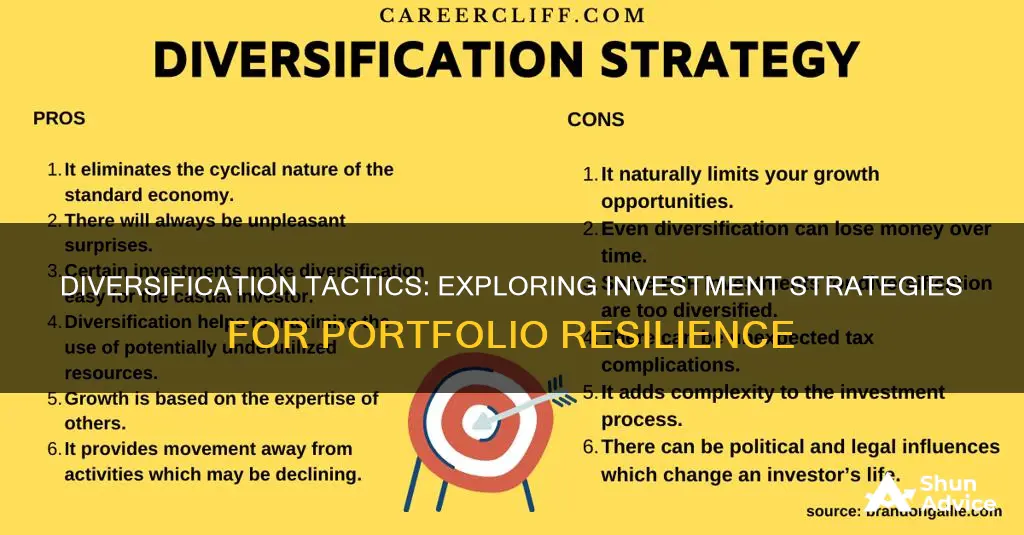
Diversification is a risk management strategy that aims to reduce the volatility of an investment portfolio by spreading investments across different asset classes, industries, and geographic regions. This strategy helps to lower the overall risk of an investment portfolio and protect against events that could affect specific investments. For example, if you only invest in US securities, your portfolio is vulnerable to US-specific risks. By investing in foreign stocks and bonds, you can increase diversification, although these investments come with their own set of country-specific risks.
To achieve diversification, investors can explore various investment options beyond stocks, such as bonds, real estate, commodities, and exchange-traded funds (ETFs). It is recommended to own at least 25 different stocks across various industries, including tech, energy, and healthcare. Additionally, investors should consider diversifying across asset classes, such as fixed-income investments (bonds), cash and cash equivalents, and real assets like property and commodities.
While diversification does not guarantee returns or protect against all losses, it can help mitigate certain risks. It is important to note that diversification may also result in lower portfolio-wide returns compared to more concentrated investments.
| Characteristics | Values |
|---|---|
| Number of stocks | Studies suggest that 15-30 stocks are enough for optimal diversification |
| Types of stocks | Tech, energy, healthcare, growth, value, large-cap, small-cap, dividend, etc. |
| Other investments | Bonds, commodities, real estate, REITs, ETFs, foreign stocks, etc. |
| Risk tolerance | Aggressive, moderate, conservative |
| Time horizon | Long-term, short-term |
What You'll Learn

Diversify across asset classes
Diversifying across asset classes is a key investment strategy to reduce risk and increase the potential for overall return. This strategy involves spreading your investments across various asset classes, such as stocks, bonds, and cash or cash equivalents. Here are some key points to consider when diversifying across asset classes:
- Stocks: Stocks allow investors to own a piece of a company and offer the highest long-term gains. However, they are also volatile, especially in a cooling economy. It's important to diversify across different sectors and industries, as well as company size and geography.
- Bonds: Bonds are fixed-income investments that pay interest to investors who lend money to a company or government. They are considered less risky than stocks and usually have an inverse relationship with stock performance. Diversifying across different types of bonds, such as government, municipal, or corporate bonds, can provide another layer of risk mitigation.
- Cash: Cash or cash equivalents, such as savings accounts or money market funds, offer stability and easy access to funds. While they have lower returns compared to stocks and bonds, they can serve as a cushion during market downturns or unexpected expenses.
- Alternative Investments: In addition to the traditional asset classes, there are alternative investments such as real estate, commodities (e.g., precious metals), and cryptocurrencies. These asset classes often have a lower correlation with the stock market and can enhance diversification.
- International Markets: Diversifying across international markets can provide further risk mitigation. Different countries and regions will have different economic cycles, so investing in a mix of developed and emerging markets can help balance your portfolio.
- Mutual Funds and ETFs: Mutual funds and exchange-traded funds (ETFs) are excellent tools for diversifying across asset classes. These funds typically invest in a specific asset class or a mix of asset classes, providing instant diversification at a relatively low cost.
- Risk and Return: When diversifying across asset classes, it's important to consider the overall potential risk and return of each class. Some asset classes, like stocks, have higher risk but also offer higher potential returns. Diversification helps to balance these risks and returns, ensuring that your portfolio is not overly exposed to any single asset class or market sector.
- Realignment: Effective diversification requires regular monitoring and realignment. Asset allocation is not static, and the performance of different asset classes and their correlations will change over time. It's important to adjust your portfolio accordingly to maintain the desired balance.
Robinhood: Still Relevant?
You may want to see also

Diversify within asset classes
Diversification within asset classes is a key investment strategy to reduce risk and increase the potential for overall return. Here are some ways to achieve this:
Diversification within Stocks
The performance of each stock is influenced by the economic cycle, with some sectors being more sensitive to economic shifts than others. Cyclical sectors include consumer discretionary (clothing, electronics, cars, etc.), financial services, basic materials, and real estate, where demand is closely tied to economic strength. On the other hand, defensive sectors like consumer staples (groceries, tobacco, etc.), utilities, and healthcare provide essential goods and services that are consumed regardless of economic conditions. By investing in a mix of cyclical and defensive sectors, you can reduce the impact of economic fluctuations on your portfolio.
Additionally, diversifying across company sizes or market capitalizations can also help manage risk. Larger companies tend to be more stable during downturns but may offer lower growth potential, while smaller companies often have higher growth potential but carry more risk.
Another dimension to consider is the style of stocks, namely growth versus value. Growth stocks are typically more expensive but are expected to have high future growth, whereas value stocks appear underpriced or undervalued relative to their potential.
Diversification within Bonds
Bonds offer different levels of creditworthiness, which influences their level of return. For example, US Treasury bonds are considered low risk, as the federal government is unlikely to default, but they offer lower returns. In contrast, bonds from other issuers, such as municipalities or corporations, may provide higher yields but carry more credit risk.
Furthermore, longer-term bonds generally offer higher returns due to their increased exposure to interest rate risk. By diversifying across bond maturities and issuers, you can balance the trade-off between risk and return.
Diversification within Stocks and Bonds: Geography
Expanding your investment scope beyond domestic markets can provide further diversification. International markets experience varied economic cycles, and by investing in both developed and emerging markets, you can access different growth opportunities and reduce the impact of country-specific risks.
Diversification through Mutual Funds and ETFs
Mutual funds and exchange-traded funds (ETFs) offer an easy way to achieve diversification within asset classes. These funds typically invest in a specific asset class, such as stocks or bonds, and may focus on a particular industry or sector. By investing in a range of mutual funds or ETFs, you can gain exposure to a diversified portfolio of stocks or bonds without needing to purchase individual securities.
Your Investment Mix: Balancing Risk and Reward
You may want to see also

Diversify by location
Diversifying your portfolio by location is a strategy that can help you manage risk and protect your investments against events that affect specific locations.
For example, if you only own US securities, your entire portfolio is subject to US-specific risk. By investing in foreign stocks and bonds, you can increase the diversification of your portfolio. However, it's important to note that foreign investments are subject to country-specific risks, such as foreign taxation, currency risks, and risks associated with political and economic developments.
Additionally, forces that depress the US economy may not affect other economies in the same way. For instance, holding Japanese stocks can provide a cushion of protection against losses during an American economic downturn.
When diversifying by location, it's crucial to consider the different categories of locations. Generally, locations have been divided into three categories: US companies, companies in developed countries, and companies in emerging markets. As globalization increases, the diversification benefits based on location are reduced. However, companies headquartered in other countries, particularly emerging markets, can sometimes perform differently than US-based enterprises.
Therefore, by diversifying your portfolio by location, you can reduce the impact of location-specific risks and increase your exposure to different economic conditions and opportunities in various parts of the world.
Protecting Retirement: Strategies to Shield Investments from Trade War Fallout
You may want to see also

Explore alternative investments
Alternative investments are any financial assets that don't fall into traditional categories such as stocks, bonds, mutual funds, and cash. They are relatively illiquid and unregulated, and they can be a great way to diversify your portfolio. Here are some alternative investments to consider:
- Hedge funds: These pool cash from multiple investors and invest it across various securities to outperform the market's rate of return.
- Private equity: This involves investing capital in private companies, including venture capital, growth equity, and buyouts.
- Real estate: This includes investing in residential, commercial, or retail properties, either individually or through a real estate venture fund or investment trust.
- Debt investing: Investors put capital into a private company's debt, which can be distressed or private.
- Commodities: Investors put money into natural resources such as oil, agricultural products, or timber.
- Collectibles: These include items such as rare wines, cars, sports cards, artwork, sculptures, and memorabilia, which are valued based on market demand.
- Structured products: These involve fixed-income markets and derivatives.
- Securitised debt instruments (SDIs): SDIs are created by pooling underlying assets such as loans, lease agreements, and invoices into a listed fixed-income security.
- Commercial real estate (CRE): CRE provides higher rental yields and longer leases than residential properties, offering higher return predictability and potential value appreciation.
- Peer-to-peer lending: This involves facilitating direct connections between borrowers and lenders via online platforms, providing alternative funding sources for individuals and small businesses.
- Cryptocurrencies: These are digital tokens based on blockchain technology, offering broader participation and significant movement over short periods.
When exploring alternative investments, it's important to understand how they work, their potential risks and returns, and how they fit with your existing portfolio. Additionally, consider factors such as time horizon, liquidity, market trends, and risk levels to make informed decisions.
Faux Fur: Sustainable Luxury
You may want to see also

Rebalance your portfolio regularly
Even the most diversified portfolio needs to be rebalanced regularly. Over time, certain investments will gain value, while others will lose it. The relative weighting of your portfolio's assets will shift as prices fluctuate, and rebalancing is necessary to realign your portfolio with your financial goals and risk tolerance.
There are two main rebalancing strategies: periodic time-based and threshold-based. Periodic time-based rebalancing involves reviewing and rebalancing your portfolio at regular intervals, such as annually or quarterly, irrespective of asset price movements. Threshold-based rebalancing, on the other hand, is triggered when your portfolio deviates from your desired target mix by a certain threshold or limit. For example, if you set a target mix of 60% stocks and 40% bonds, you might rebalance when your portfolio reaches 70% stocks and 30% bonds.
The choice between these strategies depends on your personal preferences and circumstances. The advantage of a time-based approach is that it is easier to get into the habit of rebalancing, so you don't forget to do it. However, rebalancing just because it's time may be counterproductive if your asset allocation hasn't shifted significantly. Threshold-based rebalancing, on the other hand, requires regular monitoring and may not be practical if you manage your own portfolio.
Whichever strategy you choose, it is important to review your portfolio regularly and make adjustments as needed to maintain an appropriate level of risk and ensure your portfolio remains aligned with your financial goals.
Snapchat: The Next Big Investment Opportunity
You may want to see also
Frequently asked questions
Diversification is a risk management strategy that mixes a wide variety of investments within a portfolio to reduce portfolio risk and volatility. The idea is that by holding a variety of investments, the poor performance of any one investment can be offset by the better performance of another, leading to a more consistent overall return.
Diversification can be achieved by investing in different asset classes such as stocks, bonds, real estate, or cryptocurrency. It can also be achieved by purchasing investments in different countries, industries, company sizes, or term lengths for income-generating investments.
Studies have shown that maintaining a well-diversified portfolio of 25 to 30 stocks yields the most cost-effective level of risk reduction. However, there is no magic number, and investors should consider their risk tolerance and investment goals when determining the optimal number of investments.
Yes, diversification may result in lower returns compared to investing heavily in a single winning stock. Additionally, managing a large number of investments can be time-consuming and incur higher transaction fees and commissions.







